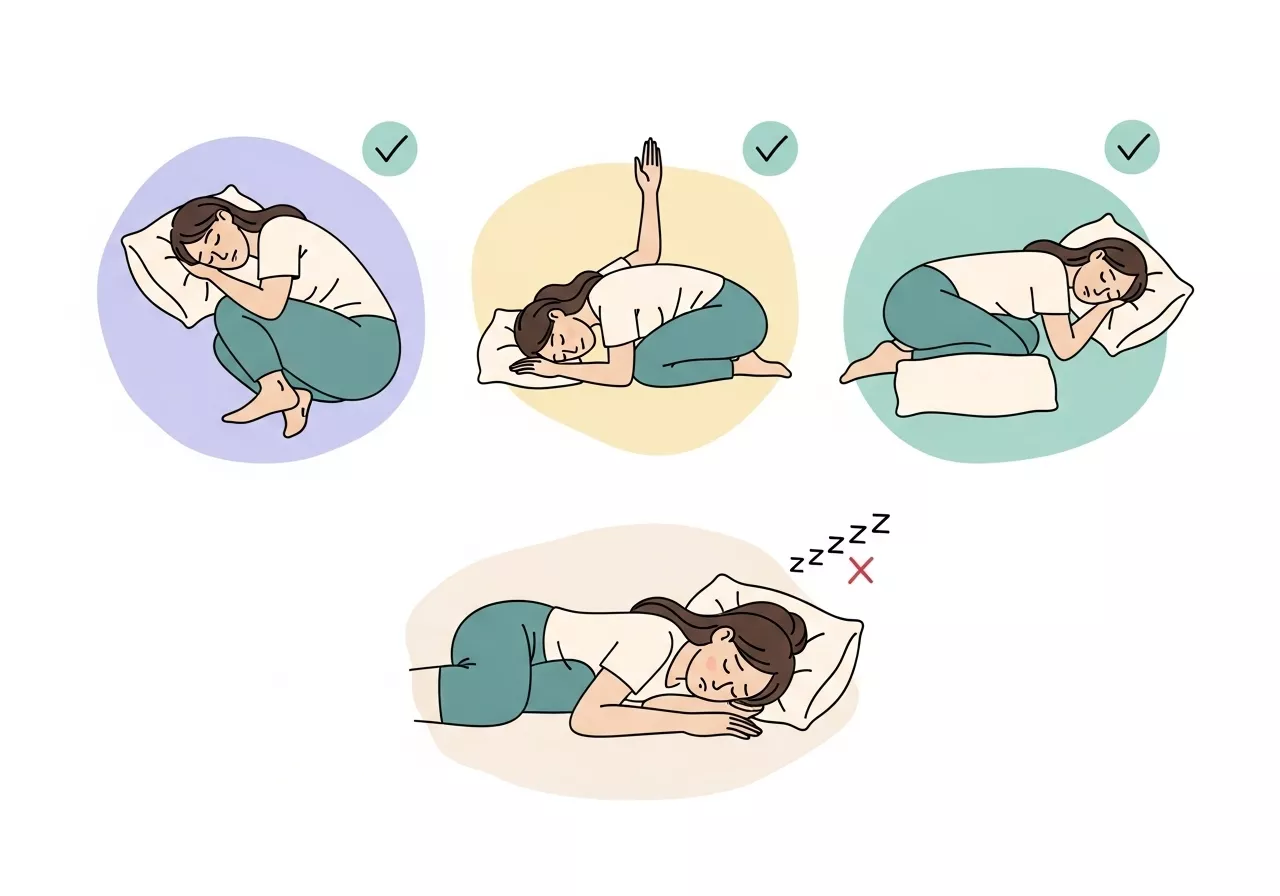These poses go beyond the individual practice, encouraging communication and teamwork.
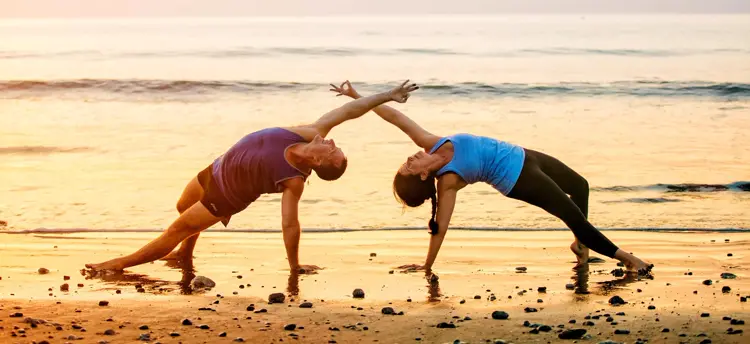
Whether you’re looking to deepen your yoga journey or simply have some fun, here are four engaging partner poses to try:
1. Double Plank
This pose strengthens the core and upper body for both partners while emphasizing trust and stability.
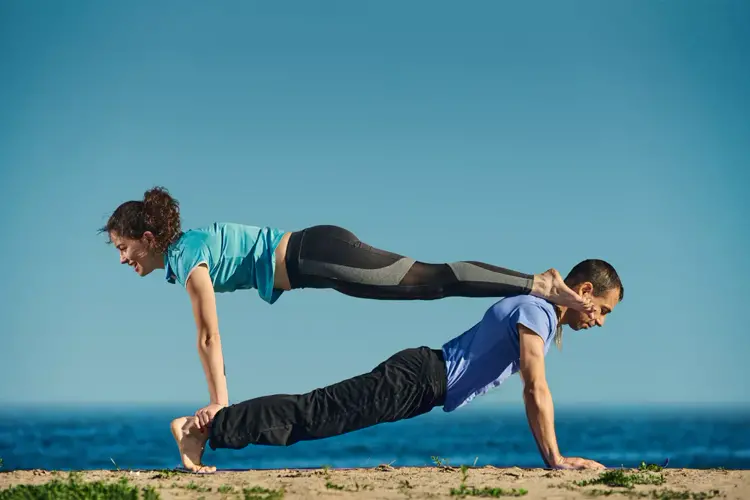
How to Do It:
- The base partner starts in a strong plank position, keeping their body straight from head to heels.
- The top partner faces the base’s feet, placing their hands securely on the base’s ankles.
- Slowly, the top partner steps onto the base’s shoulders, ensuring their balance.
- Once stable, both partners engage their core and hold the position for a few breaths.
- To exit, the top partner carefully steps down, supported by the base.
Benefits: This pose boosts core strength, promotes balance, and enhances coordination between partners.
2. Double Table
This is a playful yet effective pose to build flexibility and strength in the arms and legs while practicing trust.
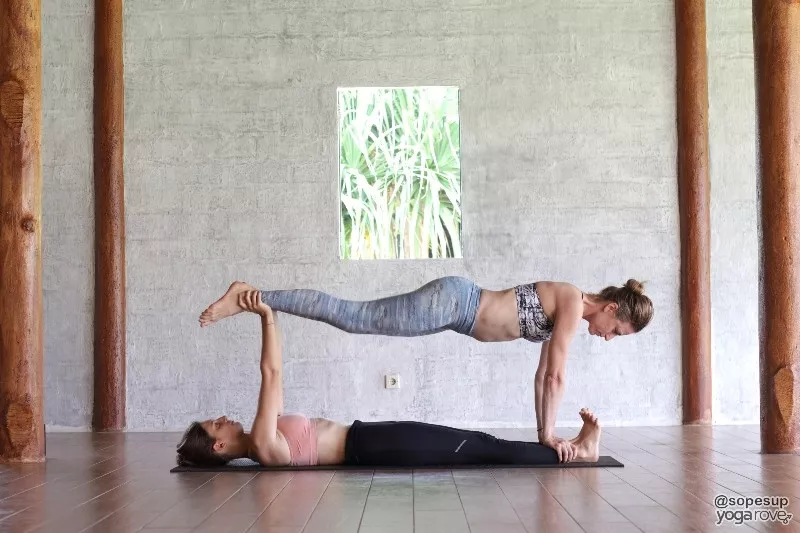
How to Do It:
- The base partner sits on the floor, leaning back slightly, and places their hands and feet on the ground to form a tabletop position.
- The top partner stands above the base and gently places their hands on the base’s shoulders while positioning their feet on the base’s thighs.
- Both partners adjust their weight and ensure alignment before holding the pose.
- Slowly and carefully, the top partner steps down when ready.
Benefits: This pose enhances shoulder and leg flexibility while reinforcing communication between partners.
3. Extended Double Table
A more advanced variation of the Double Table, this pose challenges balance and stability further.
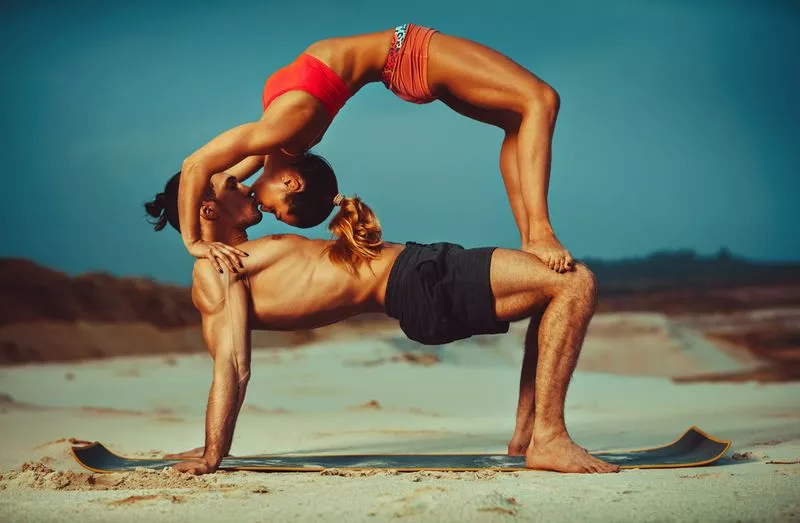
How to Do It:
- Begin in the Double Table position, with the base supporting the top partner as described above.
- The top partner lifts one leg into the air, ensuring they maintain balance.
- If stable, the base partner mirrors this movement, raising the corresponding leg.
- Both partners focus on synchronizing their breathing and maintaining alignment for several breaths.
- Carefully lower the raised legs and return to the starting position.
Benefits: This variation develops concentration, balance, and core strength for both partners.
4. Double Boat
This classic partner pose focuses on core engagement and mutual support, making it perfect for beginners.
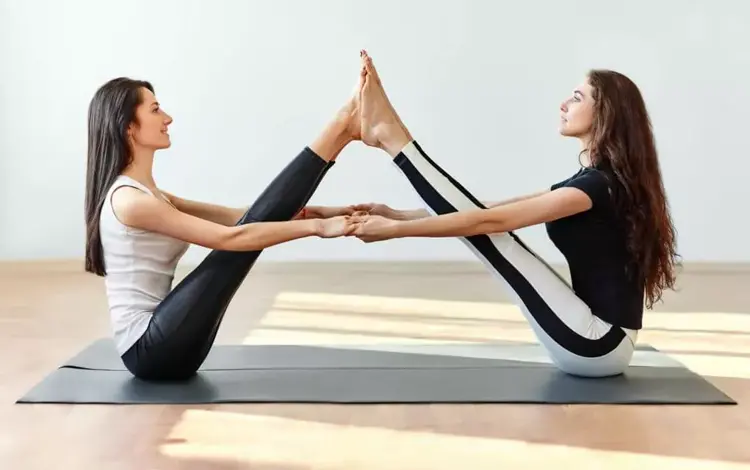
How to Do It:
- Sit on the floor facing your partner, with knees bent and soles of your feet touching.
- Both partners hold hands, lean back slightly, and engage their cores to maintain balance.
- Slowly lift your legs, straightening them upward to form a ‘V’ shape together.
- Hold this pose for a few breaths, focusing on balance and the connection with your partner.
- Lower your legs gently to return to the starting position.
Benefits: Double Boat improves posture, core strength, and flexibility while fostering teamwork.
Tips for Practicing Partner Yoga
To make the most of your partner yoga session, it’s essential to create a safe, comfortable, and engaging environment.
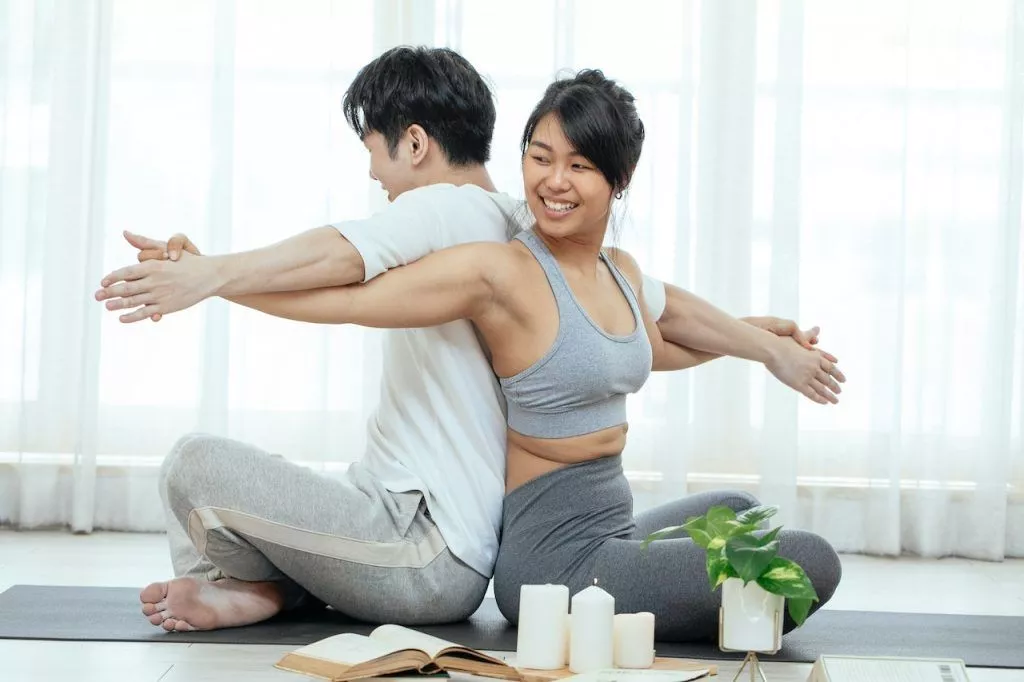
Here’s a deeper dive into helpful tips to guide your practice:
1. Communicate Clearly
Effective communication is the foundation of partner yoga. Both verbal and non-verbal cues are crucial to ensure smooth transitions and safe execution of poses.
How to Implement:
- Discuss the poses you plan to practice before starting. Agree on who will be the base and who will be the flyer (if applicable).
- Use clear, calm instructions during the practice to adjust alignment or provide feedback.
- Pay attention to your partner’s body language and facial expressions. If they appear uncomfortable or strained, pause and reevaluate.
- End each session by sharing what worked well and areas for improvement.
2. Warm-Up Together
A proper warm-up prepares your bodies for the physical demands of partner yoga, minimizing the risk of injury.
How to Implement:
- Begin with gentle joint rotations for the neck, shoulders, wrists, hips, and ankles.
- Practice a few individual yoga poses like Cat-Cow, Downward Dog, or Sun Salutations to stretch and activate major muscle groups.
- Introduce simple partner stretches such as seated forward folds with back-to-back support or partner-assisted side stretches.
- Focus on synchronizing your breath during warm-ups to create a sense of unity.
3. Take It Slow
Rushing into poses can lead to misalignment and discomfort. Approach each pose with patience and focus on proper technique.
How to Implement:
- Start with beginner-friendly poses to build trust and confidence. Examples include Double Boat and simple supported stretches.
- Break each pose into smaller, manageable steps. For instance, in Double Plank, ensure both partners achieve a solid base before progressing.
- Use props like yoga blocks, straps, or cushions to assist in achieving the correct posture.
- Avoid pushing yourself or your partner beyond their limits; it’s better to modify the pose than risk an injury.
4. Listen to Your Body
Partner yoga is about collaboration, not competition. Pay attention to how your body feels and adjust the practice to suit your physical capabilities.
How to Implement:
- Perform a body scan before and during the session to assess your comfort level.
- If a pose feels unstable or causes pain, stop and communicate with your partner.
- Use your breath as a guide—if you find it difficult to breathe deeply, ease up on the pose.
- Respect your partner’s boundaries. If they express discomfort, adjust the pose or move to a less demanding one.
5. Build Trust Gradually
Trust is essential in partner yoga, especially for poses that involve weight-sharing or balancing.
How to Implement:
- Begin with poses that require minimal physical dependency, such as back-to-back stretches or seated poses.
- Gradually progress to poses that involve more support, like Double Table or Extended Double Table.
- Maintain open communication to ensure both partners feel secure at all times.
- Celebrate small successes to build confidence and motivation for trying more challenging poses.
6. Focus on Synchronizing Breath
Breath synchronization creates a rhythm that helps partners stay connected and enhances the flow of the practice.
How to Implement:
- Before starting a pose, take a few deep breaths together to establish a calm and steady rhythm.
- Inhale and exhale in unison during poses to maintain stability and balance. For example, inhale as you lift into Double Boat and exhale as you hold the pose.
- If either partner loses breath control, pause and reset the pose.
7. Practice in a Safe Space
Your environment plays a significant role in ensuring a safe and enjoyable session.
How to Implement:
- Choose a spacious area free of obstacles like furniture or sharp edges.
- Use a non-slip yoga mat to prevent slipping during poses.
- Have soft cushions or bolsters nearby for added safety, especially for beginner acro poses.
- Ensure proper lighting and ventilation to create a calming atmosphere.
8. End with Relaxation
Every yoga practice should conclude with relaxation to release tension and foster mindfulness.
How to Implement:
- Lie back-to-back with your partner in a comfortable seated position and meditate together.
- Practice supported Savasana (corpse pose) by having one partner lie down while the other gently applies pressure to their shoulders or feet.
- Reflect on the practice, expressing gratitude for the shared experience.
By incorporating these detailed tips, your partner yoga sessions will be safer, more enjoyable, and deeply enriching for both you and your partner.
Partner yoga is an enjoyable way to strengthen not only your body but also your relationship with your partner.
These poses provide a blend of playfulness and mindfulness that will leave you both feeling energized and connected.

